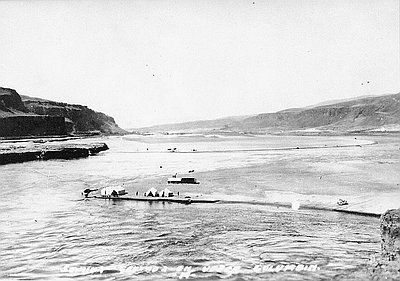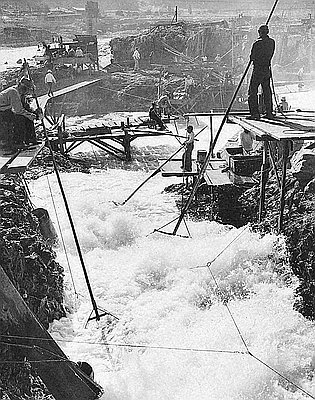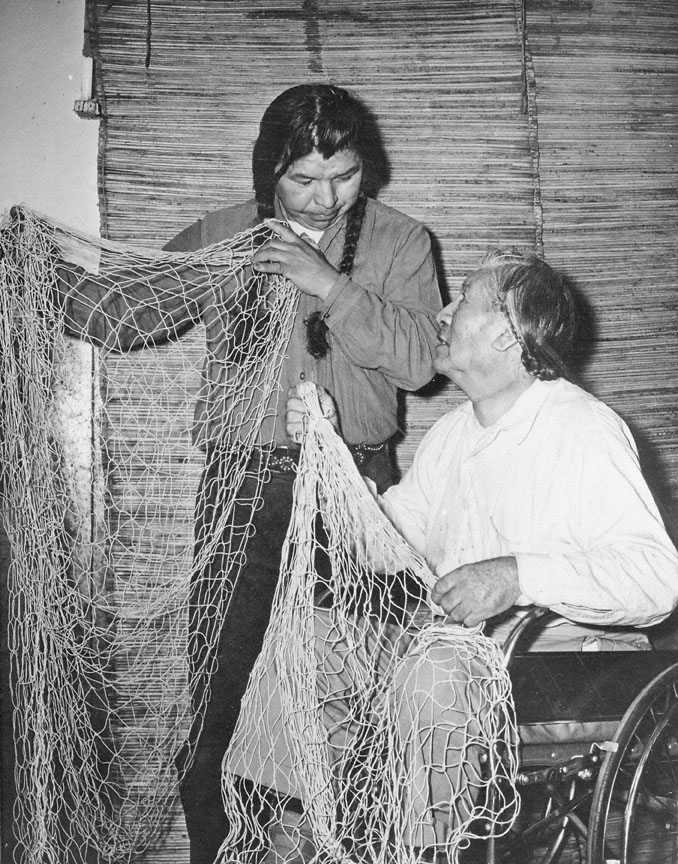- Catalog No. —
- CN 007246
- Date —
- June 1957
- Era —
- 1950-1980 (New Economy, Civil Rights, and Environmentalism)
- Themes —
- Environment and Natural Resources, Folklife, Native Americans
- Credits —
- Oregon Historical Society
- Regions —
- Central Columbia River
- Author —
- Archie McKeown, Oregon Journal
Fishing Nets
This photo shows Celilo Village residents Jimmy George, left, and Charley Quittoken, right, holding up fishing nets once used to catch salmon at Celilo Falls.
Netmaking has long been an important art among Columbia River Indians, who have relied on the river’s abundant salmon runs for millennia. Columbia River Indians traditionally made many different kinds of nets to catch salmon and other fish. The two nets shown above are dipnets, the most commonly used net at Celilo Falls prior to the construction of The Dalles Dam in the 1950s.
There are two kinds of dipnets. Movable dipnets are continually dipped into the water and swept downstream until a fish is caught. Set dipnets, on the other hand, are stationary. They are set up to catch fish falling back from a falls or strong current, as well as in eddies where fish rest.
Dipnets are effective only in turbulent waters where fish, concentrated by narrow channels and swift currents, are unable to see them. When The Dalles Dam was completed in 1957, the best dipnetting sites upstream of the dam were flooded, effectively destroying the traditional fishery at Celilo. Today, most Indian fishermen in the area are forced to use more expensive gillnets deployed from boats.
Further Reading:
Hewes, Gordon. “Fishing.” In Handbook of North American Indians: Plateau, edited by Deward Walker. Washington, D.C., 1998.
Stewart, Hilary. Indian Fishing: Early Methods on the Northwest Coast. Seattle, Wash., 1977.
Written by Cain Allen, © Oregon Historical Society, 2004.
Related Historical Records
-
Looking Downstream to Celilo
This undated photograph shows non-Indians fishing for salmon along the free-flowing and meandering Columbia River just upriver from Celilo Falls. Writing on the photograph indicates that the fishers …

-
Women Dry Salmon at Celilo Village
This photograph shows Warm Springs tribal members Edna David (left) and Stella McKinley (right) drying salmon at Celilo Village. It was taken by an Oregon State Highway Travel …

-
Indians Fish at Celilo Falls
Celilo Falls was an important center for native trade, culture, and ceremony. For at least 11,000 years, tribes throughout the region, and from as far away as the …

